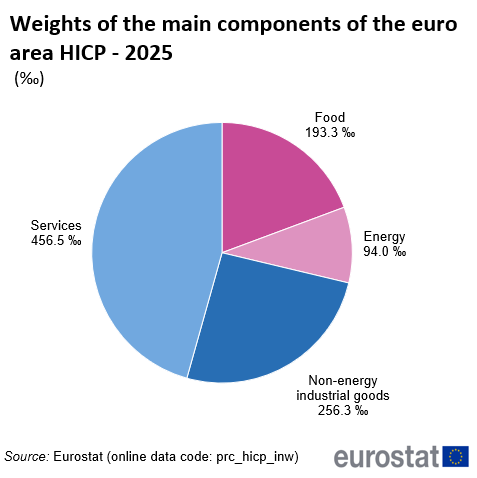Data from May 2025. Extracted on 18 June 2025.
Next planned article update: 1 July 2025.
Highlights
Euro area annual inflation was 1.9% in May 2025, down from 2.2% in April 2025.

Source: Eurostat (prc_hicp_manr)
The figures presented in this article are the actual Harmonised Index of Consumer Prices (HICP).
Euro area annual inflation rate and its main components
Euro area annual inflation was 1.9% in May 2025, down from 2.2% in April 2025. Looking at the main components of euro area inflation, services had the highest annual rate in May (3.2%, compared with 4.0% in April), followed by food, alcohol & tobacco (3.2%, compared with 3.0% in April), non-energy industrial goods (0.6%, stable, compared to April), and energy (-3.6%, stable, compared to April).

Source: Eurostat (prc_hicp_inw) and (prc_hicp_manr)

Source: Eurostat (prc_hicp_manr)

Source: Eurostat (prc_hicp_manr)
Main components of inflation
Each of the main components contributes in varying degrees to the headline inflation in the euro area. In terms of weights for 2025, 100% for the headline HICP, services is the largest component, accounting for around 45.7% of household final monetary consumption expenditure in the euro area. It is followed by non-energy industrial goods with around 25.6%.
Food, alcohol & tobacco and energy account for 19.3% and 9.4%, respectively. Together, they comprise less than one third of euro area expenditure, but they can have significant impacts on the headline inflation as their prices tend to fluctuate significantly more than the other components.
The weights of the main components of the euro area for 2025 are presented in Figure 3. Table 2 shows their relative weights for 2025.

Source: Eurostat (prc_hicp_inw)
Explore further
Other articles
- HICP methodology (updated April 2023)
- HICP at constant tax rates
Database
- Harmonised indices of consumer prices (HICP), see a predefined selection under these links:
- HICP - monthly data (index) (prc_hicp_midx)
- HICP - monthly data (annual rate of change) (prc_hicp_manr)
- HICP - monthly data (monthly rate of change) (prc_hicp_mmor)
- HICP - item weights (prc_hicp_inw)
- HICP - contributions to EA annual inflation (in percentage points) (prc_hicp_ctrb)
Thematic section
Publications
- News Release 113/2001 – First release of the Flash estimates
- News release 137/2012 – First release of the Flash estimates main components
Methodology
- Harmonised indices of consumer prices (ESMS metadata file - prc_hicp_esms)
- ECOICOP-HICP classification

